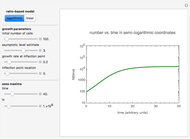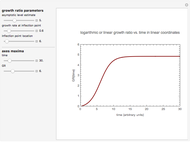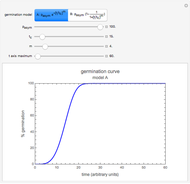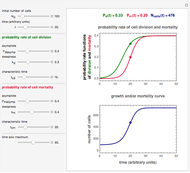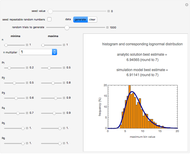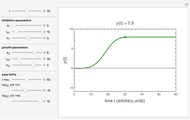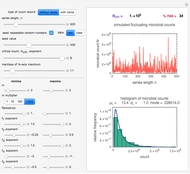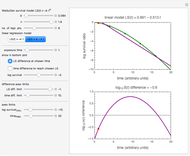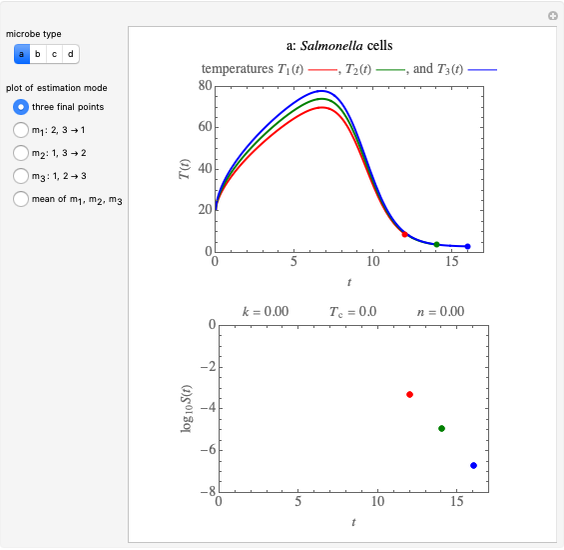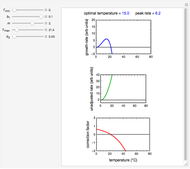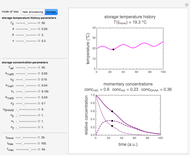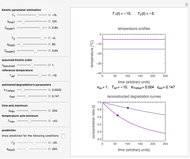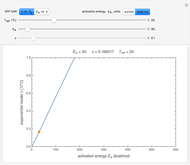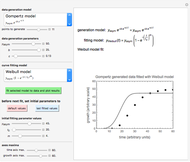Generalized Logistic (Verhulst) Isothermal Microbial Growth

Requires a Wolfram Notebook System
Interact on desktop, mobile and cloud with the free Wolfram Player or other Wolfram Language products.
This Demonstration displays linear and semi-logarithmic plots of the rise of a hypothetical microbial population's number,  , in a food at constant temperature. You can modify the growth curve by slider-controlled settings of five parameters of a conventional generalized logistic model of which the original Verhulst equation is a special case.
, in a food at constant temperature. You can modify the growth curve by slider-controlled settings of five parameters of a conventional generalized logistic model of which the original Verhulst equation is a special case.
Contributed by: Mark D. Normand and Micha Peleg (March 2011)
Open content licensed under CC BY-NC-SA
Snapshots
Details
Snapshot 1: nearly symmetric growth curve with a short lag time (when plotted on linear coordinates)
Snapshot 2: nearly symmetric growth curve with a long lag time (when plotted on linear coordinates)
Snapshot 3: classic growth curve (original Verhulst model)
This Demonstration displays linear and semi-logarithmic plots of one of the generalized versions of the logistic (Verhulst) equation formulated as  , where
, where  is the momentary number and
is the momentary number and  ,
,  and
and  are constants, with the boundary condition
are constants, with the boundary condition  . This equation can be used to model isothermal microbial growth in foods by slider-controlled manipulation of five growth parameters. The equation depicts a scenario where the momentary growth rate scales with the momentary population size
. This equation can be used to model isothermal microbial growth in foods by slider-controlled manipulation of five growth parameters. The equation depicts a scenario where the momentary growth rate scales with the momentary population size  as a power that need not be 1 and with the habitat's carrying capacity by the same or a different power. The plotted population size
as a power that need not be 1 and with the habitat's carrying capacity by the same or a different power. The plotted population size  versus time relationship is controlled by setting with sliders the population's initial size,
versus time relationship is controlled by setting with sliders the population's initial size,  , the two scaling factors,
, the two scaling factors,  and
and  , the proportionality constant,
, the proportionality constant,  , and the asymptotic level of the population's size,
, and the asymptotic level of the population's size,  . Two other sliders control the maximum settings of the time (in arbitrary units) and number of cells axes.
. Two other sliders control the maximum settings of the time (in arbitrary units) and number of cells axes.
Although the scales are set so that most of the generated curves will correspond to observable microbial growth patterns, the program can also be used to model growth phenomena in other areas such as economics.
Please note that not all possible parameter combinations necessarily yield a realistic logarithmic growth curve.
For more on the generalized Verhulst model see: A. Tsoularis, "Analysis of Logistic Growth Models," Res. Lett. Inf. Math. Sci., 2, 2001 pp. 23–46.
On the ratio-based modified version of the Verhulst model and its potential applications in food microbiology see: M. Peleg, M. G. Corradini, and M. D. Normand, "The Logistic (Verhulst) Model for Sigmoid Microbial Growth Curves Revisited," Food Res. Internl., 40(7), 2007 pp. 808–818.
Permanent Citation







